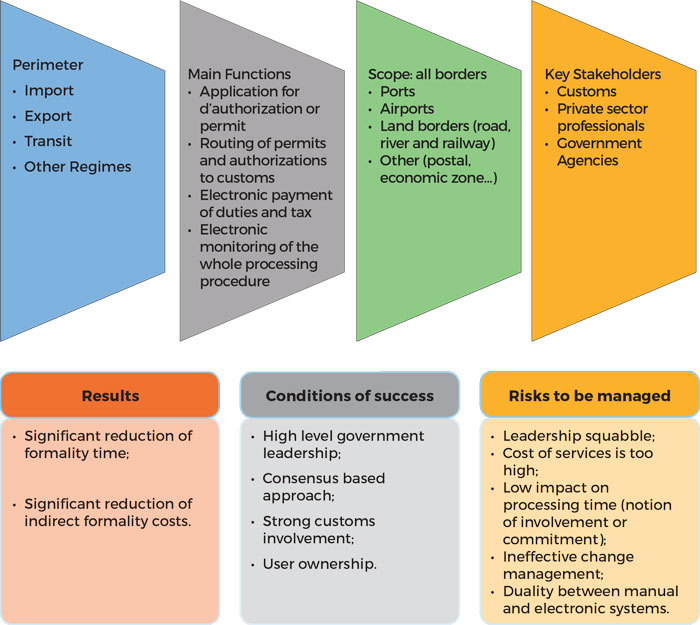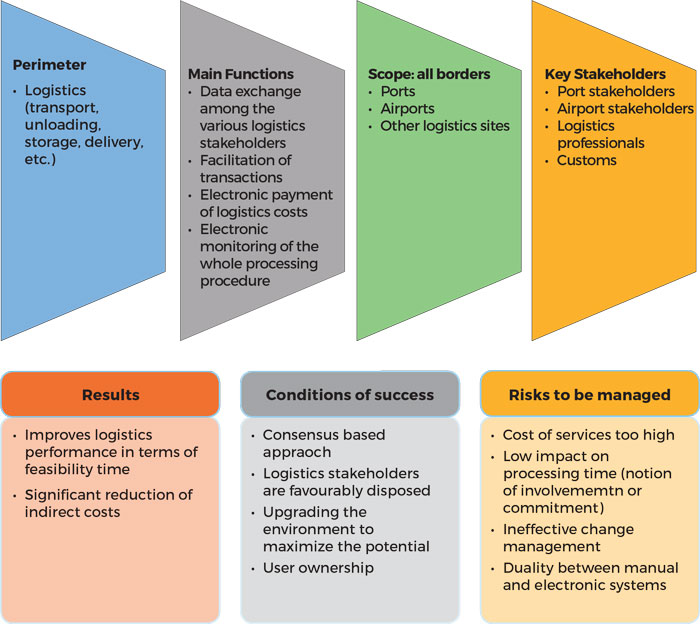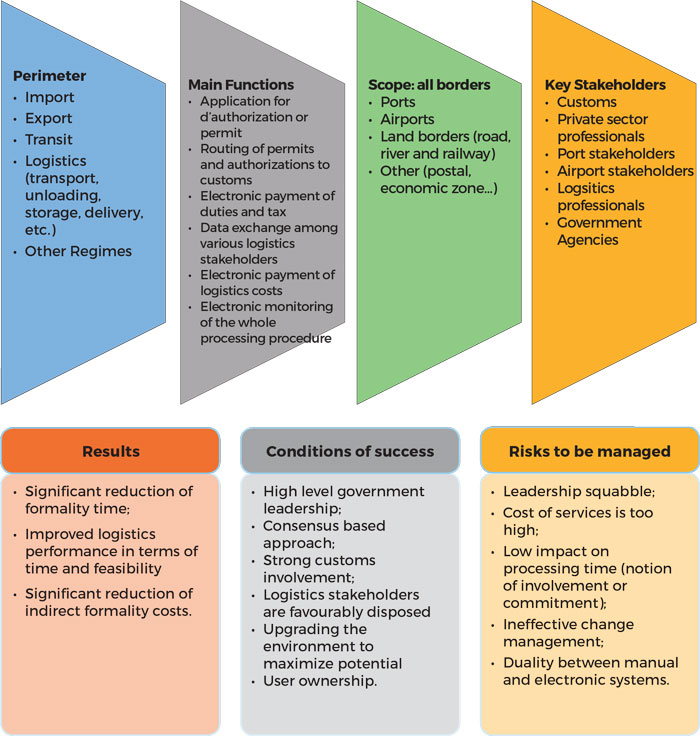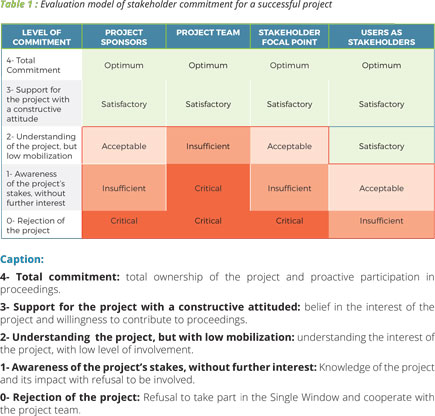Top 5 question / response
1. What are the types of Single Window and their scopes?
2. What are the key success factors?
3. What is the legal and statutory framework necessary for the implementation
of the Single Window?
Easy access to the data related to the Single Window of each country
Models of Single Windows
This guide deals with the issue of Single Window typology by insisting on the need for each country to make sure that there is always coherence and coordination. Based on the observation and analysis of existing Single Windows across the world, Single Windows can be grouped in the following three (3) major categories:
- Single Window for Foreign Trade Formalities (this Single Window takes care of all administrative formalities (public and private) required for Foreign Trade operations);
- Logistics Coordination Single Window (this Single Window is often located in a port and is aimed at processing the flow of information related to shipment and mainly involving logistics and customs stakeholders);
- National Integral Single Window (this is the combination of the previous 2 around the same technical platform and governance framework);
Description: The Single Window for Foreign Trade Formalities interconnects, around a centralized platform or through interconnection mechanisms, all the stakeholders in pre-clearance, clearance and post-clearance formalities, with a view to facilitating formalities relating to goods removal operations. Logistics stakeholders may be integrated into this type of Single Window.

Illustration : Single Window for Foreign Trade Formalities
Single Windows for logistics coordination
Description: This type of Single Window exclusively deals with logistics, notably in the port facilities. It focuses on the speed and reliability of logistics from the announcement of a vessel until the delivery of the goods to their owners. Several European ports entered the realm of Single Windows through that system also called Cargo Community System (CCS) or Port Community System (PCS). Its impact on logistics is all the stronger as volumes are high, infrastructures available and stakeholders equipped. Therefore, this tool is rather meant for large port facilities. However, some of its components may have a positive impact in smaller ports.

Illustration : Logistics Coordination Single Window
National Integral Single Window
Description: The National Integral Single Window is the form that corresponds most to the definition of Recommendation 33 and AAEC definition. It is also the most complex in its implementation, since it implies trust and collaboration among several entities that do not depend on the same authority, do not do the same job and may even sometimes have conflicting interests. It is the Single Window that interconnects, around a single platform or interconnection mechanisms, all the stakeholders in administrative, customs, port and logistics formalities. It is present across the national territory and in all modes of transport.

Illustration : National Integral Single Window
Stakeholders, those in the public sphere in particular, generally find it difficult to accept any evolution of operational procedures, even if the said evolution is likely to step up the efficiency of their daily operations. On the whole, private stakeholders (Banks, Insurance companies) are not resistant as they do identify quickly the operational and economic benefit of such an evolution like the implementation of a Single Window. The difficulty lies in public stakeholders and, it is recommended to properly unveil the stakes of the SW project to all parties in a bid to reach consensus and proper appropriation.
To this end, it is important to conduct an objective analysis of the level of stakeholders’ commitment all along the project with the view to defining a strategy for the mobilization of all.
See the table:
In a bid to have all guarantees of success of a SW project, it is essential to fathom, on a permanent basis, the level of commitment of stakeholders. This level must ideally remain all along the project, in the green section of the table above, if we want to gather all the conditions of success. Actually, a Single Window is usually perceived by stakeholders as simply prompting a loss of influence and control in the daily operations, to the benefit of other entities.
In a bid to step up the level of mobilization, it is important to communicate regularly on the project by highlighting the tangible and quantifiable gains and, the future roles devolved on each party in the new system. In addition, integrating stakeholders in the project cycle is a good practice that helps anticipate and mitigate the risks and problems that might spring up and, maintain a high level of commitment. However, if this approach appears to be inadequate after many attempts, the resort to the Governmental authority for arbitration might be necessary.
The legal and regulatory framework refers to all the laws, decrees, regulations, conventions and memoranda which may govern the procedures to be applied in Foreign Trade operations.
According to induced operational changes, the demands of the regulatory framework will be more or less high. Basically, the Single Window may follow two different legal models:
- Model 1: Single Window without recognition of electronic documents (in this model, the Single Window is a platform for the automation of data exchange processes. It does not lead to the production of any legally valid electronic document);
- Model 2: Single Window with recognition of electronic documents (the Single Window ensures the dematerialization/automation of all the procedures. All the documents and all the authorizations are electronically signed and replace paperwork 100% - paperless).
In the case of Model 1, it is not imperative to change the legal framework at the start of the project. For instance, most customs IT systems were set up in countries without any need to change the law. In this case, what is necessary is for the stakeholders to agree to receive electronic requests and electronically process them. The Customs may be connected to the Single Window platform and receive the electronic authorizations without signature.
- Law on the protection of personal data;
- Law on electronic transactions;
- Law on cybercrime;
- Law on cryptography (data transmission).
Moreover, a country’s membership of an Economic Community may also lead to challenges in the implementation of some regulations.
Thus, with regard to international documents, their validity outside borders may be questioned due to non-recognition of electronic documents or electronic signature.
Finally, strong involvement at the highest level of the State, as mentioned above, is a vital condition for the enactment of the laws, regulations and memoranda that will accompany the new Single Window procedures.
Definition of the implementation strategy.
There are three modes of implementation generally used across the world:
- Development of the solution and internal operating capacity;
- Option for a solution provider and internal operation;
- Choice of solution provider under a concession or BOT contract.
Each formula has its pros and cons, whose scope varies according to the country context. The following template raises the issue and can help decision makers find the best formula depending on the country:

The synthetic table below is based on the various options analyzed from the perspective of the designated National Champion’s capacity to pilot the implementation of a Single Window:

The business models of Single Windows are highly dependent on the initial conditions in the environment (political, economic, social and technological), but also on a good identification and management of preconditions to the start of the project.
Consequently, a detailed estimate of Single Window implementation costs remains imperative. It will be built around an inclusive approach targeting all stakeholders for good identification of needs in terms of infrastructure, equipment, human resources, training, communication, etc.
The aim is also to have a model capable of guaranteeing the balance of the three levels of funding, which are the setting up, operation and future sustainability of the Single Window.
Overall, three Single Window business models are listed:
- The public financing model;
- The Public Private Partnership (PPP) model;
- The concession model.
The public financing model
This model is used in cases where funding for setting up, operation and evolution of the Single Window is fully provided by Government or with donor support.
What moves a Government to finance the various stages of the life of a Single Window is the desire to improve the Foreign Trade environment, notably through the facilitation of trade formalities and good administration of the Single Window (e.g. Kenya, Finland, Republic of Korea, Sweden, the USA, Macedonia FYRM, Azerbaijan, Philippines, and Tunisia ).
The major risk of a strong Government involvement in financing all the stages of the Single Window lifecycle lies in the absence of resources to ensure its evolution especially in developing countries and least developed countries (LDCs). This situation could negatively impact the performances of the Single Window and, where appropriate, the option of involving the private sector and donors may be envisaged.
Very often, a donor intervenes in the setting up of the Single Window, and the State takes over to ensure its financing and operation. However, donors may intervene later in financing the evolution needs of the Single Window.
The PPP model
This model mainly relates to Single Windows set up as part of a PPP between the State and the private sector. The PPP is limited to the governance and management of the project. The rationale of improving the competitive environment of Foreign Trade is at the heart of this mutually beneficial partnership (e.g.: Ghana, Hong Kong, Japan, Malaysia, Mauritius, Senegal, Singapore, Cameroon, Morocco, Congo, etc.).
In general, Single Window services set up under PPP charge fees. But these are often negotiated or approved rates (Senegal) aimed at balancing the operation. In some cases, the use of the Single Window is optional (Germany, Hong Kong, Japan, Malaysia, Sweden, United States, Republic of Korea) while in others it is mandatory (Finland, Ghana, Guatemala, Mauritius, Republic of Korea, Senegal).
The advantage with PPP is that its complementarity with other types of funding available, as it gives the possibility, if the need should arise, to call on the Government as a stakeholder, or on donors depending on the opportunities or context.
The concession model
Following a public service concession, the private sector may finance the investment necessary for the setting up of the Single Window as well as its maintenance and operation (e.g. Germany, Guatemala). In this process, profitability of operation is a must. Thus, the facility provides paid services.
In principle, the concessionaire should directly be paid by the users on the basis of fees predetermined in the terms of the contract with the concessioning authority. In actual fact, administrations have limited competence on this type of contract. Concessionaires then take the opportunity to extend the concession time as well as the schedule of charges.
Thus, profit rationale may lead to high costs of services provided by the Single Window concessionaire. To avoid that, the Government should see to the cost effectiveness of the Single Window, by providing subsidies if needed, but also by mobilizing donors to finance the Single Window’s investment and evolution program.
Synthesis of business models
The various Single Window business models may be summarized as follows:
| Business Models | Set up Financing | Operation Financing | Evolution Financing |
|---|---|---|---|
| Public financed model | Donors/Gov | Gov. | Donors/Gov. |
| Concession model | Concessionaire | Concessionaire | Concessionaire |
| PPP model | Donor/Gov. | Ad hoc entity | Ad hoc entity |


